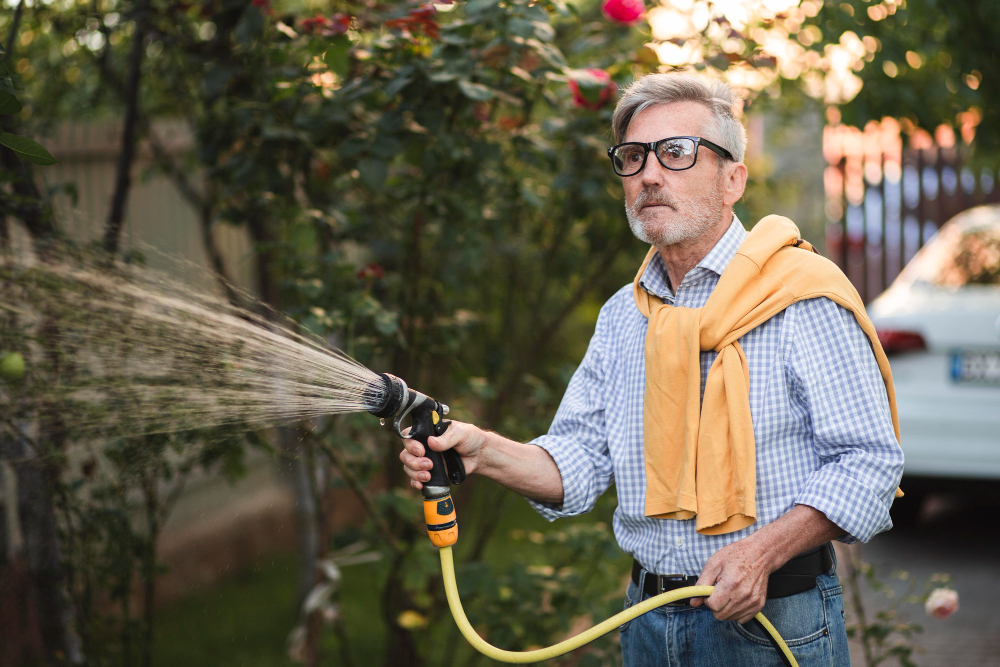Winter is coming, and with it, the challenges of maintaining a garden in cold climates. Among these challenges is the crucial task of ensuring your garden hose doesn’t freeze and crack under the pressure of ice formation.
How to Keep Garden Hose from Freezing? is a question many old and new gardeners face as temperatures start to drop.
In this post, we will explore effective strategies to prevent your garden hose from freezing, ensuring its longevity and functionality throughout the winter season.
Table of Contents
1. Draining your garden hose before the first freeze
To safeguard your garden hose from the effects of freezing, initiating the drainage process is pivotal. Following the final use of the season, disconnect the hose from the faucet to commence the water removal.
Positioning the hose with one end elevated above the other assists in thoroughly eliminating any residual water, ensuring the interior is completely devoid of moisture. This step is crucial as even a small amount of remaining water can freeze and expand, leading to potential damage.
Engage in this procedure well ahead of the first anticipated freeze to guarantee your hose remains in optimal condition, ready for use when warmer temperatures return.
2. Proper storage of garden hose
Once your garden hose has been fully drained of water, the next step is to store it correctly to prevent any possibility of freezing. A loosely coiled hose should be placed in an environment that remains consistently above the freezing point, such as a garage or basement. This method of storage helps to stave off the cold temperatures that can lead to freezing.
Also, keeping the hose off the ground and on a reel or hanger can further protect it from cold air and moisture, which are prevalent during the winter months.

Ensuring your hose is shielded from the winter elements in this way not only averts the risk of freezing but also contributes to maintaining its condition, preventing degradation from exposure to cold and moisture.
3. Utilizing insulated covers and heat tape
For gardeners who face the necessity of keeping their hoses outdoors through the winter months, or those who need access to their garden hose for winter gardening activities, turning to insulated covers and heat tape presents an effective defense strategy against freezing temperatures.
Insulated covers act as a protective sleeve for your hose and outdoor faucets, offering an additional layer of warmth in chilly environments.
On the other hand, heat tape can be carefully applied along the length of the hose, delivering a controlled amount of heat to prevent the water inside from turning to ice.
It’s important to adhere to the safety guidelines provided by the heat tape manufacturer to ensure safe usage.
4. Detaching and Storing Accessories Separately
Accessories such as spray nozzles, timers, and other attachable components are often overlooked in the winterization process of garden hoses. However, these items are just as susceptible to damage from freezing temperatures as the hoses themselves.
To avoid any potential harm, it is imperative to remove these accessories after the last use of the season. Start by detaching each item carefully from the hose, making sure to drain any water that might be trapped inside.
Once fully emptied, these accessories should be stored in a dry, warm place away from the cold, this ensures that not only your garden hose but also its accompanying tools remain in prime condition, ready for the spring gardening season.
This step is essential in extending the lifespan of your gardening equipment and preventing unnecessary repairs or replacements due to winter damage.
5. Monitoring weather forecasts
Another step on how to Keep Garden Hose from Freezing is being vigilant about weather changes plays a crucial role in protecting your garden hose from freezing conditions. Keeping an eye on weather forecasts during the winter months enables you to anticipate and respond to sudden temperature drops.
If colder weather or a freeze is predicted, it’s important to act swiftly by ensuring your hose has been emptied of water and securely stored away in a location that won’t be affected by the freeze.
This timely response is key in avoiding the stress and expense associated with fixing or replacing a hose damaged by ice.
By staying informed and reacting proactively to weather alerts, you can ensure that your garden hose remains safe from the harsh elements of winter, ready for use when the warm weather returns.





